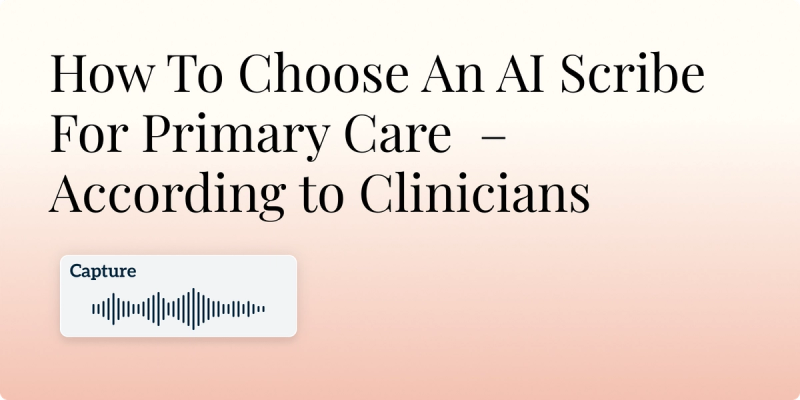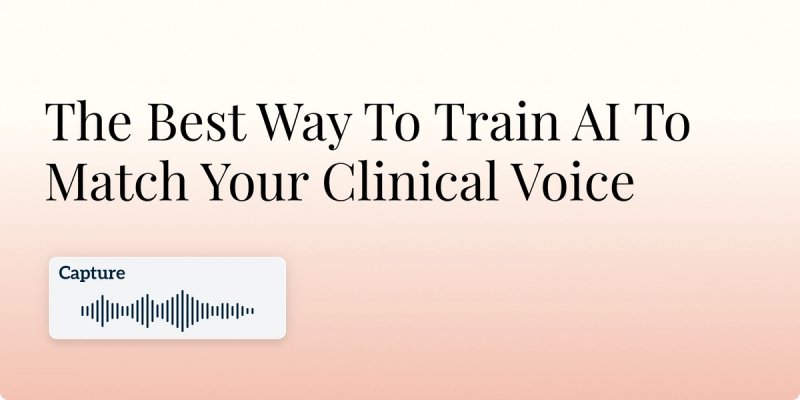
How To Choose An AI Scribe For Primary Care

Let’s be real: between 15‑minute well visits, surprise mental‑health check‑ins, and an EHR inbox that never sleeps, most family‑medicine clinicians feel like part‑time typists. An AI scribe for primary care can give you those hours back—but only if you pick one that’s tuned to the chaos of a typical day in clinic. The checklist, quotes, and FAQs below distill what front‑line doctors and PAs say actually moves the needle.
The Clinician‑Approved Checklist
Below are ten evidence‑backed criteria you can copy‑paste into your request‑for‑proposal (RFP) or trial‑evaluation sheet.
Must‑Have Feature | Why It Matters to Primary Care | Real‑World Voice |
|---|---|---|
Accurate, specialty‑tuned note output | Prevents down‑coding and re‑work during 15‑minute visits. | “The AI scribe has dramatically decreased my documentation burden and allowed me to have conversations with patients that don’t require me to divert attention from the computer screen.” News-Medical |
Templates optimized for chronic‑care and well‑visit flows | Family‑medicine encounters range from newborn checks to Medicare AWVs; templates speed the review. | n a Canadian pilot of 150 family doctors, 79 % said AI scribes let them “spend more time on patient care.” OntarioMD |
HIPAA/PHIPA‑grade security with on‑device or zero‑retention audio | Protects sensitive visit audio and mitigates consent friction. | A GP interviewed by the Daily Telegraph insisted that clinicians must “ensure responsible handling of data in line with privacy laws.” Daily Telegraph |
Low‑latency ambient capture (hands‑free) plus fallback dictation | Lets you glance at the chart only when clinically necessary. | “Those days I used the tool, it saved me about five minutes in a 30‑minute visit — huge.” PMC |
Support for multidisciplinary teams | PAs, NPs and residents can all share one workflow and vocabulary set. | A physician‑assistant reviewer wrote, “It changed my practice…telehealth aspect is awesome.” |
Transparent AI audit log and easy editing | Regulators increasingly expect provenance for AI‑generated content. | “It’s easy to correct occasional typos; low cognitive lift,” noted one study participant. PMC |
Native integration with your EHR (Epic, athenahealth, PCC, etc.) | Eliminates copy‑paste loops (“pajama time”) after clinic. | Kaiser Permanente researchers found that ambient scribes produced “statistically significant reductions in note‑taking time and work after hours.” American Medical Association |
Training and change‑management services | Adoption fails if front‑desk staff and nurses aren’t coached. | “Everybody needs to try it…I have colleagues asking, ‘How did you get this?’” |
Proven ROI in primary‑care settings | Look for peer‑reviewed or real‑world time‑savings data, not marketing decks. | OntarioMD’s trial showed 3–4 hours/week of paperwork eliminated for most family physicians. |
Vendor road‑map & funding stability | Avoid the risk of sudden price hikes or product sunsets. | A family doctor leading an Ontario project stresses that AI scribes must “benefit family doctors, patients and the health system.” Amplify Care |
*Last verified January
Deep‑Dive: What Clinicians Really Say
- “I can finally look patients in the eye again. The note writes itself in the background.” — Dr Marco Lo, family physician Amplify Care
- “De‑scribing helps me complete records more accurately without extra clicks.” — Verified physician review on Capterra
- “Rolling out AI scribes is one way we can help prevent the family‑medicine crisis from becoming a catastrophe.” — Kimberly Moran, Ontario Medical Association CEO OntarioMD

Red‑Flag Questions to Ask Every Vendor
- Where is raw audio stored and for how long?
- Show a note generated from a complex multi‑problem visit.
- How do you tune language models for diverse accents?
- What happens if Wi‑Fi drops mid‑visit?
- Can clinicians edit with voice or keyboard inside the EHR?
- Is pricing per seat, per note or unlimited?
- Will you sign a BAA (U.S.) or IPA (Canada) at no extra cost?
Conclusion: The Bottom Line
A decade of studies and real‑world pilots agree on one takeaway: ambient AI scribes give clinicians back face‑to‑face time while slashing after‑hours charting. Your ideal solution will tick every box in the 10‑point checklist above.
If you want a vendor that already supports primary care workflows, Twofold Health offers a HIPAA‑compliant, self‑service platform with proven note accuracy, transparent pricing and hands‑on onboarding. Try the 20‑note free trial to see if it fits your clinic before you commit.
Less typing, more medicine — that’s the promise. Make sure your AI scribe delivers it.
Frequently Asked Questions
ABOUT THE AUTHOR
Dr. Danni Steimberg
Licensed Medical Doctor
Reduce burnout,
improve patient care.
Join thousands of clinicians already using AI to become more efficient.

How to Catch Up on Your Therapy Progress Notes
Behind on documentation? Learn proven, HIPAA-smart ways to clear your therapy-note backlog, speed reimbursement, and stay audit-safe—powered by Twofold Health.

The 'Standardized' Patient Problem: Is AI Forcing A Homogenized View Of Healthcare?
AI risks creating a homogenized view of patients, leading to biased therapy notes. Explore the dangers of algorithmic bias and how to mitigate them effectively.

The Best Way To Train AI To Match Your Clinical Voice
Generic AI notes create more work, not less. Learn the steps to customize your AI clinical notes, ensuring they mirror your critical reasoning and save time.

